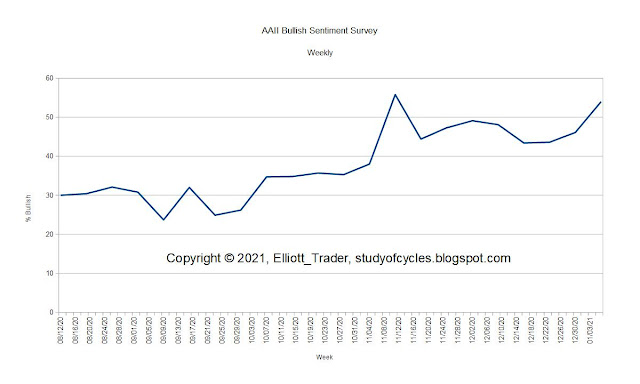I first became aware of the McClellan Oscillator on the New York Stock Exchange many years ago when Sherm McCleallan was presenting it himself on the FNN channel (Financial News Network). I followed it for a very long time, and tried to see if it could assist in predicting market turns. For those who are interested the McClellan Oscillator (or $NYMO on Stockcharts.com) is essentially a momentum oscillator on the New York Stock Exchange advance-decline line. It's calculation can be found at this LINK. Here is the recent chart of the daily $NYMO.
 |
$NYMO - Daily - Divergences
|
Essentially, this indicator is "like" a MACD of the advance-decline line (or $NYAD). The issue is how well does it work? Well, we know as recently as this week stocks as measured by the ES futures made an all-time high. Yet, the $NYMO shows a series of declining peaks. Now let's look at the $NYAD raw data in cumulative format.
 |
$NYAD - Daily - Curling Over
|
Last week, we showed the $NYAD and said that its most recent up moves were very, very hesitant and it showed signs it might curl over. As the solid line above shows, the raw $NYAD has indeed curled over in its largest down move since November.
At this point, a simple visual comparison shows what might be called a "negative bias" in the McClellan Oscillator. In other words, the Oscillator points lower in several spots when the raw data recovers and makes a new high - and, in this case, the market index along with it. It is really necessary to recognize this aspect of this tool used by many to help with market timing. Yes, it might help one if it is used as a 'divergence' indicator.
But one should also recognize for how long it can be incorrect. The most significant divergence (June to December) was fully two months early in its timing. While this may be important information, one must certainly be judicious in its eventual application.
If you are not familiar with this technical tool, it has a companion indicator called the Summation Index, shown below. What it does is sum the daily $NYMO values over time. If the $NYMO is negative at the time, it adds the negative number, meaning values below zero are definitely possible.
 |
NYSE Summation Index ($NYSI) - Daily - Range
|
This index has a distinct personality of traveling between +1,200 and -1,200 which also means there are numerous times when it will "return to zero". Sometimes, not always, the return to zero is a relatively quick trip representing a downward impulse-like move in the markets. Other times, the index takes a much more meandering trip to the zero line. This was the case in the Intermediate (B) wave to the 2020 high, and lower low in the Intermediate (C) wave down in March.
Yes, this index can be used as a divergence indicator as well - seemingly better at tops. Some of the bottoms are "spike" bottoms with a V recovery, so caution is needed in looking for divergence at the lows. Not even the 2009 bottom shows divergence at the lows. However, there is an excellent example of divergence at the lows in the Summation Index at the 2002 - 2003 lows. But, rather than 'spoon-feed' readers of this blog, I'll let the interested reader plot this last example using Stockcharts.com - which is free - to find this example and make sure they are familiar with these helpful tools.
Ultimately, one needs to be cautious using most market indicators - including this one - in surveying for market turns. While such indicators may be screaming that a turn is due, sometimes is takes a very long time to see that turn materialize.
For a wave-counting site, if we can not find a count completion that works simply and naturally while the indicators are in warning mode, we generally assume that the indicator is a little pre-mature: giving a good warning, but maybe there is more to go.
We hope this reality review of the way things have actually worked versus the way they are supposed to work has been helpful. Have an excellent start to the weekend. And, a brief reminder, this was the second post this weekend if you have not seen the first one.
TraderJoe




































